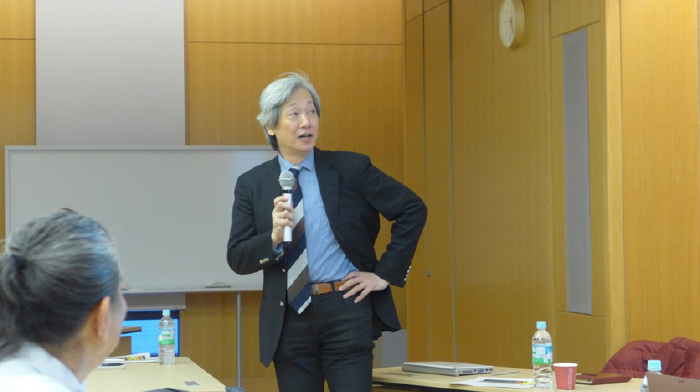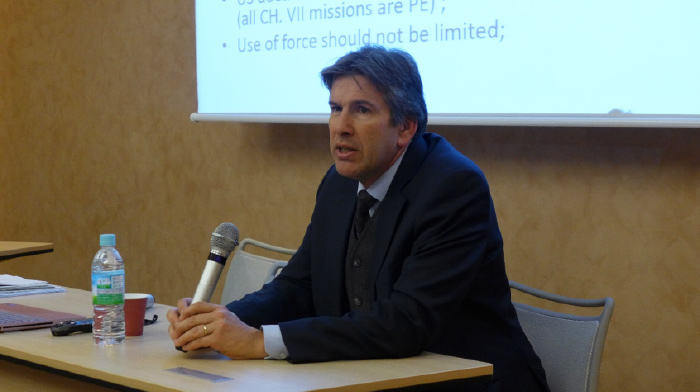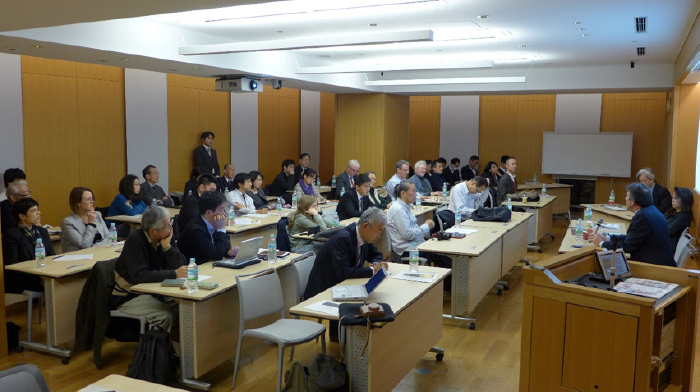SSU Forum with Dr. Cedric de Coning and Professor Chiyuki Aoi
| Date: | Friday, February 24 2017, 17:30-19:00 |
|---|---|
| Venue: | Seminar Room, 3rd Floor, Ito International Research Center |
| Subject | Is UN peacekeeping still relevant in a time of increasingly violent conflict? - A critical reflection on UN Peacekeeping Doctrine in a New Era |
| Lecture: | Dr. Cedric de Coning, Senior Research Fellow, the Peace and Conflict Research Group, the Norwegian Institute of International Affairs(NUPI) Professor Chiyuki Aoi, Graduate School of Public Policy, the University of Tokyo |
| Language: | English |
| Co-hosted by: | Security Studies Unit, Policy Alternatives Research Institute, the University of Tokyo, Graduate School of Public Policy, the University of Tokyo |
The Security Studies Unit was delighted to host a talk dedicated to the new book edited by Dr. Cedric de Coning, Prof. Chiyuki Aoi and Dr. John Karlsrud, and entitled “UN Peacekeeping Doctrine in a New Era”. The forum hosted two of the co-editors. Cedric de Coning is Senior Research Fellow at the Peace and Conflict Research Group at the Norwegian Institute of International Affairs, as well as Senior Advisor on Peacekeeping and Peacebuilding for ACCORD. Chiyuki Aoi is Professor of International Security at the Graduate School of Public Policy, the University of Tokyo.

The session was opened by SSU Director Professor Kiichi Fujiwara, who introduced Dr. de Coning as a distinguished expert on UN peacekeeping and Prof Aoi on stabilisation.
Professor Aoi introduced herself to the audience and started to illustrate the purpose and content of the book. The premise of this new publication is that UN peacekeeping practice has undergone considerable change in recent years that may challenge the basic rationale of peacekeeping operations. Peacekeeping as a practical invention has evolved all the time, but recent years have witnessed in a rapid pace the rise of missions with protection mandates without the usual entry-benchmark of a peace agreement. The UN has also been mandated to protect governments against insurgencies in the DRC and Mali. In the DRC we have witnessed the unprecedented use of the Force Intervention Brigade (FIB) with an offensive mandate to “neutralize” armed groups. In Mali, it was notable that UN peacekeeping went in despite a high degree of destabilisation. The UN is increasingly being asked to deal with such “stabilisation” mandates under situations where consent is unstable or non-existent, and the government too fragile, with only a concept fitted for peacekeeping. These developments remains however under-theorised: while there are implications for the current formulation of the UN doctrine concerning peacekeeping, an explicit appraisal of this new constellation of elements still has to be formalised. The book is therefore focusing on this problematique. It is also remarkable that book-sized publications on this topic are in reality quite rare. In terms of content articulation, the book provides an overview of the conceptual and doctrinal developments in UN peacekeeping operations from an historical perspective.
Professor Aoi gave an overview of the various parts of the book, particularly focusing on the difference between doctrinal definitions of peacekeeping and stabilisation. She also highlighted the variety of views on this matter not only among scholars, but also practitioners and diplomats at the UN, representing the different positions held on this topic by, amongst others, the permanent members of the Security Council and major troop contributing countries.

Dr. de Coning introduced the current debate on UN peacekeeping by recalling some of the events of the 1990s that has influenced the current UN doctrine. During that decade, severe loss of life in numerous crises, most notably in Rwanda, led to a re-orientation of UN peacekeeping operations around a new core objective, namely the “protection of the civilians”. Currently most UN troops are deployed in missions with this explicit goal. In the past most missions were mandated to help implement comprehensive peace agreements, today most missions are mandated to protect civilians in situations where no peace agreement is in place. This situation has compelled the UN to become increasingly “robust”: whereas in the past UN troops could only use force in self-defence, since 2008 UN peacekeeping doctrine allows UN peacekeepers to not only use force in self-defence, but also in defence of the mandate. The doctrine allows the tactical use of force, provided that the host government has given its consent to the mission. These developments has had theoretical and practical implications for the way the key principles of peacekeeping: consent, impartiality and the use of force is understood and practiced.
In the past five years a new concept of stabilisation has started to be used in UN peacekeeping mandates. Currently four missions (in Haiti, DRC, Mali, Central African Republic) is considered stabilisation missions. The book seeks to answer the question how does UN stabilization missions differ from UN peacekeeping missions? The meaning and implications of the use of a stabilization approach in UN peace operations have not yet been addressed by UN policies or doctrine. Diplomats are careful not to suggest that a major conceptual shift is occurring, and perhaps understandably so from their perspective, as it may open complex and uncomfortable discussions. However, on the other hand it is difficult to deny that some kind of shift is occurring, and that it is opening up a gap between current doctrine and the operational reality of these stabilization missions. This gap leads to misunderstandings between the UN Security Council’s intent, the way missions are planned and managed, the expectations of the troop contributing countries as well as that of the host nation. The wider the gap the greater the risk for failed expectations as well as greater risk for the civilians the peacekeepers are mandated to protect, as well as for the peacekeepers themselves.

